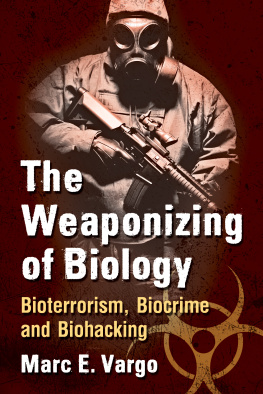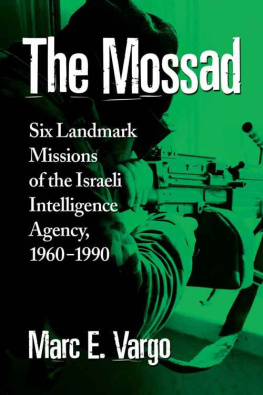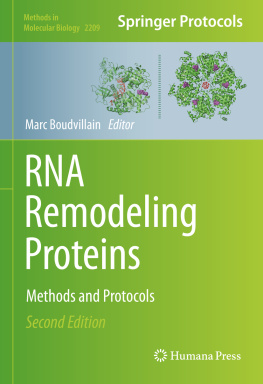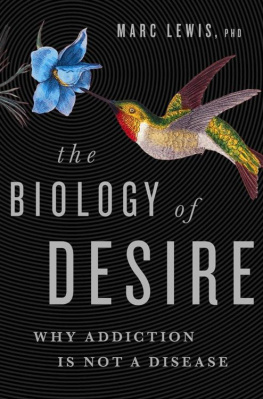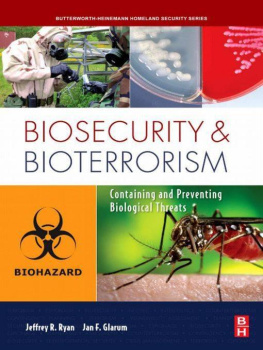Marc E. Vargo - The Weaponizing of Biology: Bioterrorism, Biocrime and Biohacking
Here you can read online Marc E. Vargo - The Weaponizing of Biology: Bioterrorism, Biocrime and Biohacking full text of the book (entire story) in english for free. Download pdf and epub, get meaning, cover and reviews about this ebook. year: 2017, genre: Politics. Description of the work, (preface) as well as reviews are available. Best literature library LitArk.com created for fans of good reading and offers a wide selection of genres:
Romance novel
Science fiction
Adventure
Detective
Science
History
Home and family
Prose
Art
Politics
Computer
Non-fiction
Religion
Business
Children
Humor
Choose a favorite category and find really read worthwhile books. Enjoy immersion in the world of imagination, feel the emotions of the characters or learn something new for yourself, make an fascinating discovery.
- Book:The Weaponizing of Biology: Bioterrorism, Biocrime and Biohacking
- Author:
- Genre:
- Year:2017
- Rating:5 / 5
- Favourites:Add to favourites
- Your mark:
- 100
- 1
- 2
- 3
- 4
- 5
The Weaponizing of Biology: Bioterrorism, Biocrime and Biohacking: summary, description and annotation
We offer to read an annotation, description, summary or preface (depends on what the author of the book "The Weaponizing of Biology: Bioterrorism, Biocrime and Biohacking" wrote himself). If you haven't found the necessary information about the book — write in the comments, we will try to find it.
Marc E. Vargo: author's other books
Who wrote The Weaponizing of Biology: Bioterrorism, Biocrime and Biohacking? Find out the surname, the name of the author of the book and a list of all author's works by series.
The Weaponizing of Biology: Bioterrorism, Biocrime and Biohacking — read online for free the complete book (whole text) full work
Below is the text of the book, divided by pages. System saving the place of the last page read, allows you to conveniently read the book "The Weaponizing of Biology: Bioterrorism, Biocrime and Biohacking" online for free, without having to search again every time where you left off. Put a bookmark, and you can go to the page where you finished reading at any time.
Font size:
Interval:
Bookmark:

Also by MARC E. VARGO
The Mossad: Six Landmark Missions of the Israeli Intelligence Agency, 19601990 (McFarland, 2015)
Women of the Resistance: Eight Who Defied the Third Reich (McFarland, 2012)

McFarland & Company, Inc., Publishers
Jefferson, North Carolina
LIBRARY OF CONGRESS CATALOGUING DATA ARE AVAILABLE
BRITISH LIBRARY CATALOGUING DATA ARE AVAILABLE
e-ISBN: 978-1-4766-2933-9
2017 Marc E. Vargo. All rights reserved
No part of this book may be reproduced or transmitted in any form or by any means, electronic or mechanical, including photocopying or recording, or by any information storage and retrieval system, without permission in writing from the publisher.
Front cover images 2017 iStock
McFarland & Company, Inc., Publishers
Box 611, Jefferson, North Carolina 28640
www.mcfarlandpub.com
For Eric and Adam Vargo
Evil is only good perverted, writes Henry Wadsworth Longfellow in his narrative poem, The Golden Legend. Certainly there is truth in the renowned poets words, with the corruption of good being readily observable throughout the course of human history, perhaps most notably when that which was intended for the benefit of humankind has been upturned and used as a truncheon against it.
The discipline of biology offers an example, a field of study in which scientists insights into the intricacies of life have at times been misused by malevolent actors committed to delivering agony and death, and in a most insidious manner: through the spread of disease. And this is not a recent development. Biological aggression in all of its varieties has, for centuries, been a bane to humanity, a practice that cultures around the world have denounced over and again as a singularly despicable and intolerable form of violence. Yet it continues to occur sporadically in both Eastern and Western nations.
In the pages that follow, three categories of biological aggression are examined: bioterrorism, biocrime, and biohacking. Whereas the first two classifications, by definition, culminate in acts of violence, the third category, biohacking, refers to a newly-emergent movement that entails do-it-yourself biology (DIYbio) and to date presents only the potential for biological aggression.
The first portion of the book, Part One, examines the fundamental concepts and features of bio-aggression, and, as such, serves as a primer on the subject. The first chapter traces the history of biological warfare from its practice by Chinese warriors nearly five thousand years ago through its use in the Middle Ages and Renaissance to its manifestation in the modern era. In the course of this historical survey, a little-known attempt to deploy a virus to assassinate President Abraham Lincoln in the nineteenth century is revisited, as are pivotal advances in the state-operated biowarfare programs of Germany, Japan, the former Soviet Union, and the United States in the twentieth century. Examined, too, is the growth of non-state bioterrorism in the present century, with a spotlight on the al-Qaeda network.
Chapter 2 centers on the various ideologies that characterize terrorist organizationspolitical, religious, and special-interest philosophies and agendastogether with such entities motives, short-term objectives, and long-term goals. Emphasis is placed on the types of extremist groups that biodefense specialists believe are most inclined to use biological weapons, along with the rationales behind the experts opinions. The discussion concludes by bringing to light a particularly devious form of assault known as a biocrime, including the ways in which it differs from bioterrorism as well as the reasons that a perpetrator may turn to such an unorthodox mode of aggression.
Biohacking is the subject of Chapter 3, with the text tracing the origin and development of the DIYbio movement, which is currently thriving. It is one in which people from all walks of life, many of whom lack formal training in the life sciences, carry out biological or bioengineering experiments in their homes, community-based workshops, specially designed hacklabs, or other alternative settings. The potential hazards of this largely amateur endeavor are explored, most notably the concerns voiced by professional microbiologists, geneticists, bioengineers, and biodefense experts. Among their reservations: the possibility that an experiment by a citizen biologist may go awry and sicken or kill a swath of the population, or that a group of rogue biohackers may deliberately target individuals or groups with a pathogen, perhaps an augmented, genetically-engineered microbe capable of producing unforeseen damage. The counterarguments of biohacking advocates are presented as well, rejoinders to what they consider their opponents inflated fears, with such enthusiasts offering several reasons that they believe the benefits of do-it-yourself biology far outweigh the risks of a biological calamity. The discussion concludes with a look at two codes of ethics that biohacking networks have proposed in Europe and North America in an effort to help prevent biological accidents and discourage premeditated pathogenic attacks.
Turning to specific pathogens and toxins, Chapter 4 summarizes the features of those microscopic entities that the Centers for Disease Control and Prevention considers to be prospective agents in a biological offensive. These include the bacteria that produce anthrax, botulism, plague, tularemia, Q fever, and salmonellosis; in addition, the viruses that lead to Ebola and Marburg Virus Diseases, smallpox, and other conditions. The principal modes of pathogen dissemination are also outlined, specifically person-to-person, airborne, foodborne, waterborne, and vector-borne transmission.
Having covered the essentials of biological aggression, the remainder of the book, Part Two, provides an assortment of cases illustrating the diversity of biocrimes and bioterrorism attacks. Chapter 5 revisits several of the former that occurred in the field of medicine in recent years, culminating in a detailed recounting of the notorious case of physician Debora Green and her efforts to use a lethal plant toxin as a weapon. Chapters 6 and 7, on the other hand, showcase the latter, namely two precedent-setting, large-scale bioterrorism attacks orchestrated by extremist religious sects in the United States and Japan. Lastly, Chapter 8 provides an extensive account of the deadly anthrax offensive that followed in the wake of the World Trade Center and Pentagon attacks of September 11, 2001. The text further delves into the possible perpetrators of this historic offensive, including the FBIs third and final suspect whose purported guilt remains debatable to this day.
All in all, the book, by furnishing an up-to-date overview of bioterrorism, biocrime, and biohacking, serves as a timely reminder of the dangers posed by those individuals and organizations who set out to subvert the life sciences so as to produce illness and death for their own dubious ends. As Longfellow would undoubtedly concur, biological aggression, like chemical and nuclear warfare, is a classic example of good perverted, as well as a form of violence that carries the potential to endanger the entirety of humanity itself.
Part OneConcepts
Font size:
Interval:
Bookmark:
Similar books «The Weaponizing of Biology: Bioterrorism, Biocrime and Biohacking»
Look at similar books to The Weaponizing of Biology: Bioterrorism, Biocrime and Biohacking. We have selected literature similar in name and meaning in the hope of providing readers with more options to find new, interesting, not yet read works.
Discussion, reviews of the book The Weaponizing of Biology: Bioterrorism, Biocrime and Biohacking and just readers' own opinions. Leave your comments, write what you think about the work, its meaning or the main characters. Specify what exactly you liked and what you didn't like, and why you think so.

